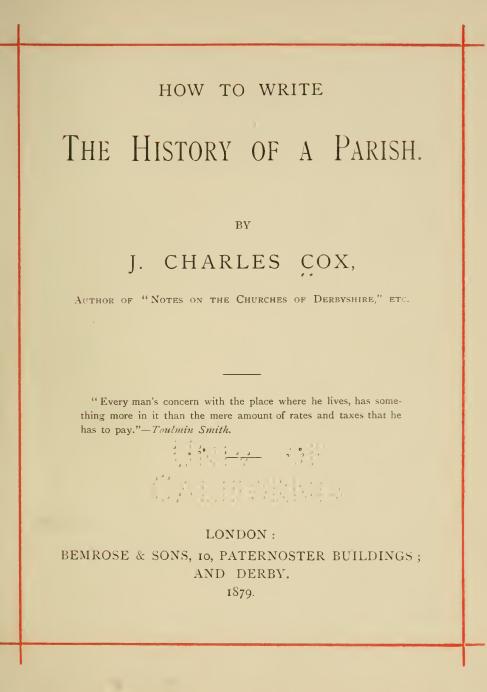J. Charles Cox
 The Rev. John Charles Cox (1844-1919) was perhaps one of the most influential English local historians of the nineteenth century. Anyone studying early modern Derbyshire quickly comes across his work. He published dozens of books, including calendars of local records, a four-volume history of Derbyshire churches, and a detailed study of All Saints, Derby. Even if you don’t know anything about Derbyshire, you may still have encountered his influence if you are interested in early modern parish history. In 1879, Cox published the first edition of a guide on How to Write the History of a Parish that would become the textbook for generations of historians and genealogists. It discussed step-by-step the local and national sources needed to reconstruct the history of an early modern parish. It was a runaway success, and was reprinted a number of times.
The Rev. John Charles Cox (1844-1919) was perhaps one of the most influential English local historians of the nineteenth century. Anyone studying early modern Derbyshire quickly comes across his work. He published dozens of books, including calendars of local records, a four-volume history of Derbyshire churches, and a detailed study of All Saints, Derby. Even if you don’t know anything about Derbyshire, you may still have encountered his influence if you are interested in early modern parish history. In 1879, Cox published the first edition of a guide on How to Write the History of a Parish that would become the textbook for generations of historians and genealogists. It discussed step-by-step the local and national sources needed to reconstruct the history of an early modern parish. It was a runaway success, and was reprinted a number of times.
Cox was born in 1844 in Parwich in Derbyshire. He attended Repton and Somerset College in Bath, before starting a degree at Queen’s College, Oxford in 1862. Financial pressures – he was the second son and needed to find a secure income – led him to leave after three years without taking a degree, to take up a position as partner at the Wingerworth Colliery Company. Two years later, he married Marian Smith, the daughter of a local squire with whom he would go on to have ten children. They settled in Belper in Derbyshire.
Cox quickly got involved in local politics, becoming a magistrate and sitting on a number of local boards. He was a Liberal who became friends with Sir Charles Dilke, a high-flying politician who would become notorious in 1885 after an alleged fling with Virginia Eustace Smith during the first year of her marriage to the MP Donald Crawford. He was a trade unionist who became a regular on the left-wing speaking circuit in the 1870s, stating:
That there should be classes that exclusively labour, and others that exclusively enjoy, and have the privilege of unlimitedly expending the fruits of other men’s labour, is opposed to reason, justice and Christianity.
To the left of the Liberal Party, he diverged from Gladstone over disestablishment of the Church of England and the Church’s role in education. Just before the 1874 election he stood as an Education League candidate in the Bath by-election, against a sitting Liberal MP. The latter’s supporters caused uproar at an open meeting Cox was addressing, throwing him out of a first-floor window. Fortunately he survived his defenestration, as members of the local constabulary were standing beneath and managed to catch him.
In 1879 Cox started studying for the priesthood at Lichfield Theological College, becoming an Anglican priest in 1881. After a series of livings he was awarded a lucrative Crown placement in Holdenby in Northamptonshire. With a parish of fifteen people, this left ample time to devote to the historical research into parish archives that he had already been carrying out in Staffordshire and Derbyshire. During this time Cox was also taking pioneering approaches to what he called the ‘parish state’: insisting that the local could not be understood without reference to the national, an approach which is now second nature to post-revisionist historians of early modern England. In line with his politics, he was particularly concerned that the poorer members of past societies had the right to have their voices heard, and made innovative use of vestry minutes to uncover the plight of the poor in early modern parishes.
Many of Cox’s works are now out of copyright and are starting to appear on the Internet Archive. I also cannot recommend highly enough Elizabeth T. Hurren’s excellent article on Cox in Rural History (2008), from which much of the biographical information in this post is drawn.












